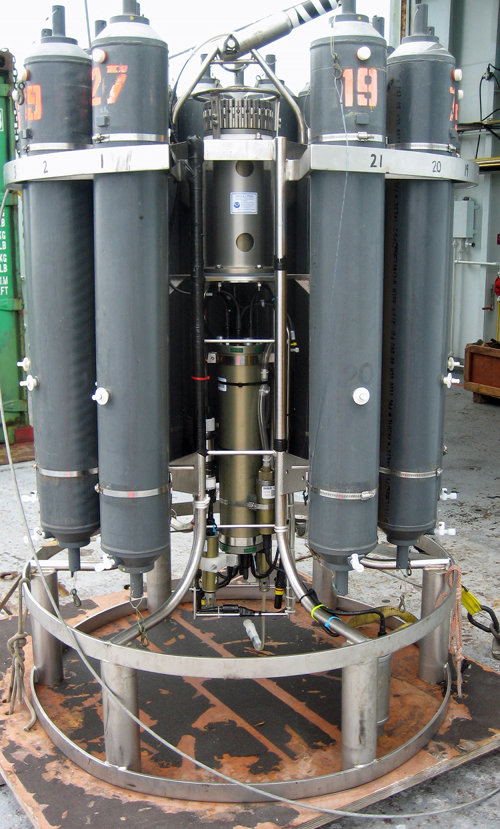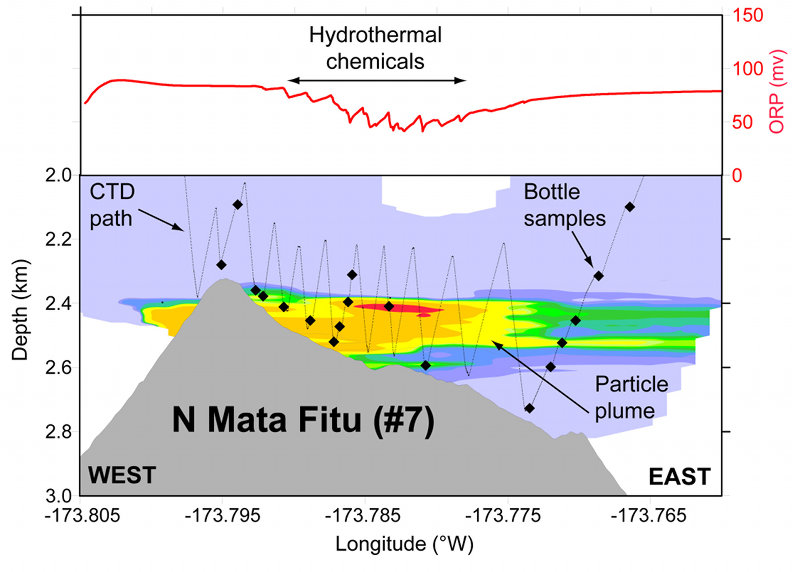
By Ed Baker, Supervisory Oceanographer
and Joe Resing, Chief Scientist
NOAA Vents Program, PMEL
The seafloor of the Northeast Lau Basin is one the most volcanically active areas known to scientists. Magma from deep within the crust upwells to the seafloor to form long ridges and symmetrical volcanoes. Cooling of the magma creates seafloor hot springs (hydrothermal vents), which construct mineral deposits, nurture unique biological communities, alter deep-sea circulation patterns, and profoundly influence ocean chemistry and biology. Seafloor hydrothermal sites are a submarine version of Yellowstone National Park. But instead of forming a warm pond, as at Yellowstone, the hot fluid rises into the cold ocean, cooling as it mixes with the cold seawater. Mixing continuously dilutes the hot discharge and increases its volume as it rises, until the hydrothermal plume achieves neutral buoyancy and is dispersed by the local currents. These shifting, drifting plumes act as a tool to locate the small and sparse vents that discharge the fluids, and also provide information about the chemistry of the hot springs fluid.

A closeup of a CTD, the primary tool used to map hydrothermal plumes. A ring of plastic sampling bottles surrounds the CTD. The bottles are closed on command from the ship, usually when a scientist monitoring the sensors sees strong evidence of a plume. CTD sensors are visible at the bottom of the pressure case. Image courtesy of NOAA Vents Program. Download larger version (jpg, 2.4 MB).
As a trail of wind-blown smoke draws the eye to a smokestack, so do oceanographers use maps of hydrothermal plume tracers that lead back towards a field of vents. The tracers can be physical measurements such as changes in temperature, salinity, and optical characteristics of the water. Chemical characteristics of the plume are also used, including various trace metals and gases common in a hydrothermal discharge. A survey we conducted at N Mata Fitu during our 2010 expedition to the Lau Basin provides a good example.
Our basic tool, used by oceanographers around the world, consists of a Conductivity-Temperature-Depth (CTD) package combined with sampling bottles that can be closed on demand. Added to the CTD are specialized sensors that can detect specific hydrothermal tracers. We use two sensors routinely. One measures light scattering and indicates the concentration of small particles in the water column, such as elemental sulfur and particulate iron, which precipitate from their dissolved state in the hydrothermal fluids. Another measures oxidation-reduction potential (ORP) and is sensitive to the concentration of various dissolved chemicals, such as hydrogen sulfide, in the plume. At Mata Fitu, we did a “tow-yo“ over the volcano summit, continually raising and lowering the CTD within the bottom few hundred meters of the water column while the ship steamed slowly ahead at a speed of about 1.5 knots. This technique allowed us to precisely determine the shape of the hydrothermal plume and thus the location of its source on the seafloor.

Results from a CTD tow-yo over Mata Fitu in 2010. The bottom panel shows the CTD path over the volcano profile. Light-scattering values define the plume; red colors are the highest particle concentrations, blue colors are the lowest concentrations. The top panel shows the change in ORP values during the tow. Higher chemical concentrations are denoted by negative deflections in the ORP value. Image courtesy of NOAA Vents Program. Download larger version (jpg, 757 KB).
The light-scattering sensor mapped out a plume of hydrothermal particles about 200 meters thick, centered around the summit of Mata Fitu, and growing more dilute (lower particle concentrations) as it was carried to the east by the local currents. This distribution showed us that hydrothermal vents were located not on the summit, which is most common, but on a gentle slope on the eastern side of the summit. The sources must be no deeper than ~2.6 kilometers, which marks the bottom of the plume.
Other processes, such as resuspension of bottom sediments by the local ocean currents, can also form particle plumes. The ORP sensor on the CTD, however, showed that this plume was hydrothermal. Each time the CTD dipped into the plume, the ORP sensor value decreased as it detected reduced chemicals, causing a series of wiggles as the CTD went into and out of the plume. The observation that the ORP sensor fluctuations ended as it got farther from the summit also proves that the source of the fluids is on the volcano flank.
As we towed, we tripped sampling bottles to determine the chemistry of the dissolved and particulate material in the plume (see the bottle locations in the figure). Such measurements provide valuable clues about the nature of the hydrothermal activity that generates the plume. Gases such as helium and hydrogen are telltale signs of ongoing volcanic activity, and were both found at Mata Fitu. Methane, a gas produced by both volcanic activity and biological processes, was also abundant. Manganese and iron are both common in high-temperature (>~300°C; >~570°F) hydrothermal fluids, and were also abundant in this plume, as were particles of elemental sulfur. These characteristics imply that Mata Fitu hosts vigorous, high-temperature hydrothermal vents. An extensive biological community probably thrives on an associated discharge of low-temperature fluids.
In 2010, we explored for hydrothermal plumes over all seven of the N Mata volcanoes. Remarkably, we found evidence for hydrothermal vents on six! We thus have more volcano targets than we have time to explore in 2012 as we return with sophisticated vehicles to image and sample the seafloor. Even so, we remain deeply in the explorative stage of this research. We were surprised in 2010 by more discoveries than we expected, and marveled at the variety of chemical compositions in the many plumes we found. Many targets are known, but many more sites remain to be explored. The ocean is a harsh and unyielding environment, and new progress is hard won. But the excitement and value of increasing our knowledge of one of Earth's basic processes makes this exploration among the most rewarding we can imagine.